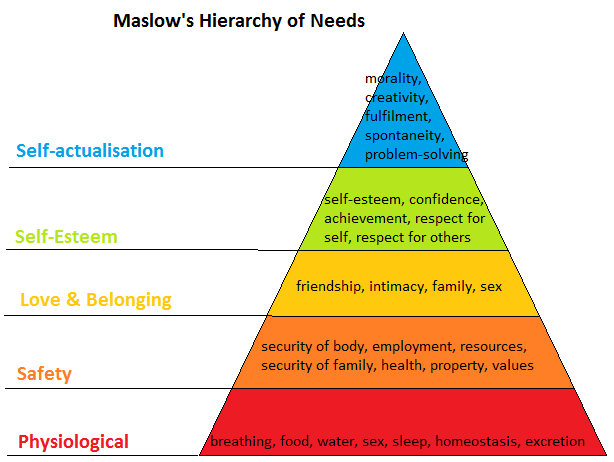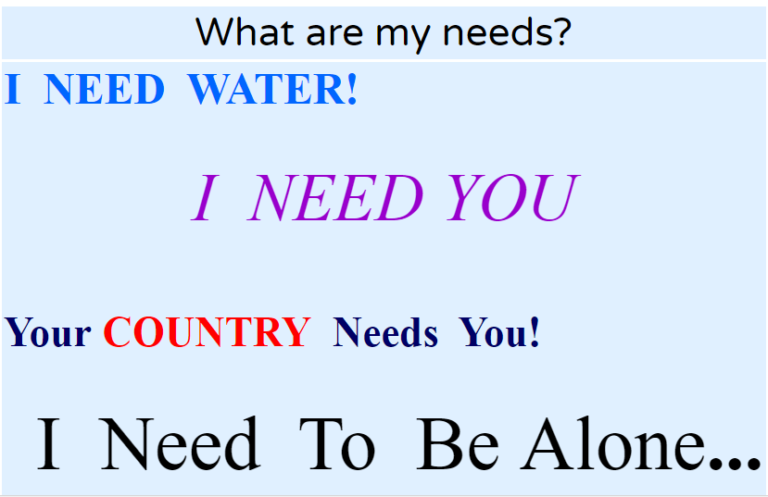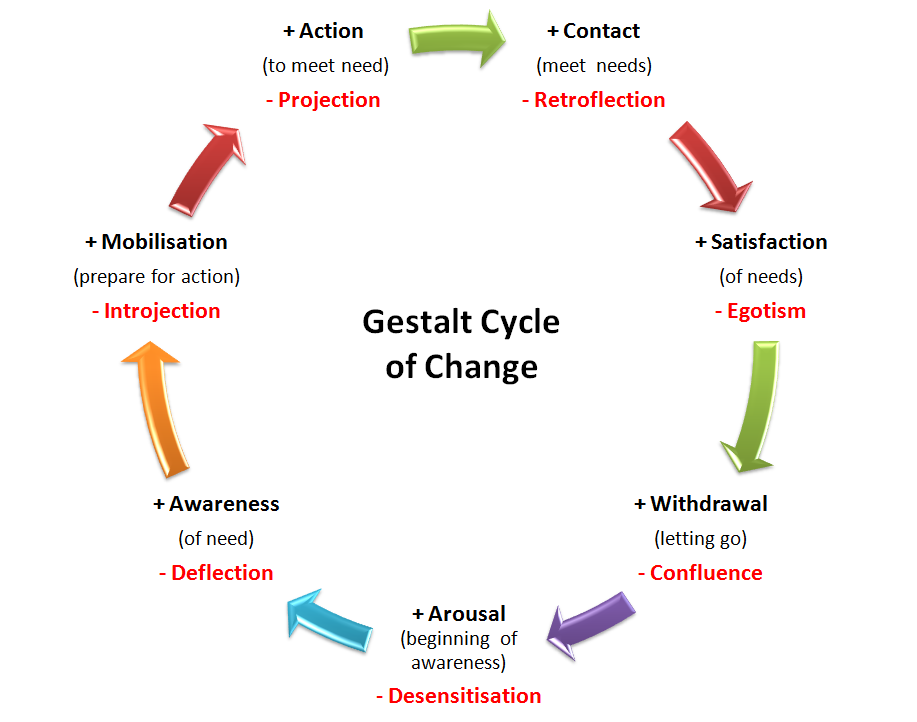

Gestalt Cycle of Change Counselling
At the heart of my vision of Mindfulness is the belief that as human beings we need to engage with all aspects of our nature, as whole beings living in the present moment. This means moving towards a deepening of experience and awareness of our mental states, physical sensations, emotions and relationships in order to find fulfilment. Mindfulness is about making better contact with ourselves and others so that we can have a more satisfying experience of the world. Understanding the process of how we make contact with ourselves and each other can be extremely helpful for personal growth and healing. Having a sense of how we fail to make contact with ourselves can also be useful, if we struggle to meet our own needs. Maslow created a hierarchy of human needs, which he represented in the diagram above. Maslow believed that these needs play a major role in motivating behaviours which propel us towards growth and change. If these needs are not met by ourselves, others or the environment in which we live then a sense of deficiency arises, meaning we feel deprived. As if an obstacle were blocking our sense of fulfilment. Satisfying our basic needs is important in order to avoid conflicted emotions or distress. Maslow referred to the most essential need as our basic needs, which are vital to survival – such as air, water, food and sleep. He suggested all other needs are secondary until these physiological needs are met. He described our highest-level of need as self-actualisation. This need stems from a desire to grow and develop as a person; to become the best we possibly can be, by fulfilling our potential. There are five different levels in Maslow’s hierarchy of needs:
Physiological Needs - material needs of the body to survive as a living organism such as food, shelter, air and water.
Security Needs – the need for safety and security, but not as demanding as physiological needs. Although a permanent state of insecurity can result in high levels of stress and fear that will eventually diminish our ability to survive.
Social Needs – these include a sense of belonging, love and affection that are met in friendship, romantic attachments and families. These help fulfil our desire for adult companionship and self-acceptance; as well as our involvement in social networks, communities or religious groups.
Esteem Needs - after the first three needs have been satisfied, self-esteem becomes increasingly important otherwise we lose our sense of purpose and self-worth. These include the need for things that reflect on our identity such as a sense of personal worth, social recognition and approval from parents.
Self-actualizing Needs – this is the highest level of Maslow’s hierarchy of needs. Self-actualizing people are aware of themselves as whole, integrated persons. They are concerned with personal growth and fulfilling their potential in life rather than being overly concerned with the opinions of others.

Another way of understanding our needs and how we reach our full potential is represented in the gestalt cycle of change. Gestalt theory provides a model for how we become mindful of our needs and how we meet them. The Cycle of Change model suggests that we can fulfil our needs by engaging in a full cycle of contact with the world – moving from a state of arousal, to awareness, to motivation, action, full contact and finally a state of withdrawal and rest. As in Maslow’s theory, if there is any interruption or disturbance at the contact boundary, because our needs are not being met, this can lead to a deep sense of dissatisfaction. Change is a normal, healthy and vital condition of existence in order that we learn, evolve, grow and flourish. All Life comes from a process of change in order to adapt and survive. This is our nature. In a healthy cycle, we emerge from a state of potentiality where all possibilities exist; becoming aware of something ‘missing’; consciously identifying the ‘need’ to be met; preparing ourselves to act; acting to meet that need; enjoying the satisfaction of that need being met; and then returning to a state of rest where all possibilities exist.
The gestalt cycle of change is a way of understanding this. A need arises during an internal sensation (such as a fantasy, or memory) or an external stimulus (such as a threat), where the individual experiences something that interrupts the restful state. That awareness arises through a blend of physical sensations, feelings, thoughts and perceptions that seek to interpret the experience. If the sensation holds sufficient enough attention for the individual, then awareness of that need begins to sharpen. Energy is mobilized in response to this awareness and motivates us towards seeking satisfaction or fulfilling that need. The energy is released through our actions and contact is made at the boundary in order to satisfy that need. During contact, the new experience is assimilated into our being (as a new skill, a memory, or a feeling of accomplishment). When what is new or different has been assimilated and adapted to, change occurs within the organism. Once the original need has been met the individual returns to a restful state by withdrawing from the experience and closing the cycle.
If however, there is an interruption or disturbance at the contact boundary then that need may not be met and a sense of dissatisfaction will occur. In other words, a break in the cycle of experience would be a break in the movement towards growth and fulfilment. If an we habitually interrupt this cycle of experience because we want to avoid repeating past experiences, this interrupts our ability to complete the cycle. This is known as “unfinished business”. It leaves its legacy and can easily distract us or prevent us from moving forward. More importantly however, we can learn to break these patterns, by interrupting the interruptions so that the cycle can move towards full completion and fulfilment. This is the cycle below:
- A sensitisation claims the attention of the organism
- Awareness develops inducing anxiety/excitement
- Mobilizing energy for action
- Action leads to contact with a new boundary, creating the conditions for change
- Successful contact is followed by a sense of satisfaction or fulfilment
- Then withdrawal into a state of assimilation, until
- Closure re-structures experience and a return to a state of rest
The mindfulness exercises I have designed for practice on this website should enable you to complete the gestalt Cycle of Change:
- Sensitisation– using a body scan to seek physical sensations, feelings, needs or thoughts
- Awareness– developing non-judgemental awareness of a need by staying with the sensation, feeling or thought then letting go; or attuning to the needs of others
- Mobilizing the energy for action– breathing exercises, stretching, muscle priming or reaching out to others with empathy
- Action– activity such as mindful walking which seeks contact with the need or non-verbal attunement which provides or the needs of others
- Contact– meeting the need, or making contact with the needs of others
- Satisfaction- the need is assimilated or integrated creating the conditions for change
- Withdrawal– once contact has been made and assimilated a person can withdraw and rest (such as sleep) since the need is no longer present
- Closure– change or transformation occurs as a result of contact with the need and then a person returns to a state of rest
In Gestalt Theory when there are interruptions or disturbances to the boundaries in the Cycle of Change then the needs of the person cannot be met and fulfilment cannot be accomplished. At each stage of the cycle boundary disturbances have consequences:
- Desensitisation- is diminishing one's emotional responsiveness to negative stimuli from the environment or others.
- Deflection - means moving the contact boundary through avoiding behaviours e.g. changing the subject in a conversation.
- Introjection- by 'swallowing experiences whole'. If the client is constructively learning to assimilate and reject new ideas and experiences by being in contact with his feelings then needs can be met. Introjection, however, is when new experiences I fully assimilated without question or discretion. This may include being brainwashed by someone else’s values when we are young, or over-identification with people we idealise and mimicking their behaviour, but not being ourselves. Introjecting anger results in a fear of being consumed by it.
- Projection– is the confusion of “Other” for what should be the “Self“. It is projecting feelings I find unacceptable in myself onto others e.g. someone who has a bad day and is angry with themselves, may shift blame to another or project anger onto a loved one. It may be a child attributing their feelings onto a “transitional” object e.g. Teddy is angry with Mummy.
- Retroflection– is withholding emotions or responses intended for other people e.g. if we become angry with the boss but hold back on our anger at work. Or if we withhold intimacy and affection from loved ones. Some people hold in anger a lot of the time, without channelling it later and the result is exploding with anger.
- Egotism- is when there is no effort at interaction or interplay between one person and another; an exchange that only goes one way e.g. a person is so into himself and talking about himself at a meeting, without listening to or noticing anyone else.
- Confluence– is the boundary-less sensation of merging with a loved one, or sense co-dependency. It is the loss of distinction between Self and Other. A lack of awareness at the contact boundary. “You” and “I” to become “One” or soul mates. Pleasing others to the detriment of ourselves.